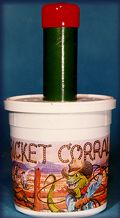

|
|
IDEASWHATEVER...
Scientists get a grip on gecko's secretStephen Humphries BERKELEY, CALIF A new scientific discovery about geckos has scientists climbing up the walls: Researchers have concluded that the lizards utilize subatomic molecular attraction to shimmy their way up vertical surfaces. The key to geckos' cling lies in millions of microscopic hairs, called setae, that line their feet. A single hair can support the weight of an ant, thanks to forces of attraction resulting from interactions between the positive and negative charges of protons and electrons. Cameras took 1,000 pictures a minute to help analyze the motion of geckos' feet. It was discovered that the geckos uncurl their toes slightly, which allows them to unstick the hairs on their feet - in much same the way that one peels tape off a surface.
Researcher Robert Full of Berkeley University in San Francisco, envisions adapting the geckos' secret for technological uses. "One could develop a general dry adhesive that stays clean. It would be velcro which doesn't require two pieces," he says in a telephone interview. If scientists successfully find a way to replicate these atomic forces, then such an adhesive could even be used underwater or in space. The research was funded by IS Robotics Inc. The company has since copied the gecko's toe motion to develop a robot prototype that is able to climb walls (though not as fast as the reptiles) with pressure-sensitive glue adhesive on the machine's "feet."
Geckos are nature’s
| |||||||||||||||||||||||||||||||||||||||||||||||||||||||||||||||||||||||||||||||||||||||||||||||||||||||||||||||||||||||||||||||||||||||||||||||||||||
 When the snake wants a snack, reach for the Cricket Corral (Pet Tech) |
Pez Dispenser
for Crickets
Darby Cunningham and David Rose recently received U.S. patent 5,630,374 for a
device that they say turns reptile feeding into an orderly, nontraumatic affair.
Think of it as a Pez dispenser for crickets.
Essentially, it’s a plastic container with a 9-inch-long tube sticking out of
the top. The idea is that you put a few dozen crickets inside the container,
place the cover on top and then stick in the tube, which is capped with a top
that has tiny air holes punched into it.
Pretty soon, all of the crickets will have climbed up
into the tube, and you won’t see any in the container itself.
“We took advantage of the natural instincts of a
cricket—which is to climb and hide in a dark place,” Rose says.
The inside of the tube has an “attractive dark
interior,” Rose’s patent notes, that is rough in texture so crickets hang on
easily.
Icky No Longer
When your bearded dragon gets a cricket craving, pull the tube off and shake out
a few critters.
“You just give it a little tap and they begin to fall
out,” Rose says.
The hungrier your pet, the more you tap. When you’re
done, insert the tube back into the container.
Produced by Pet Tech of Van Nuys, Calif., the Cricket
Corral retails for about $7. It features pictures of cowboy lizards lassoing and
branding crickets.
So far, the Cricket Corral is especially popular among
mothers, Rose notes.
“Moms can be squeamish about dealing with them,” he
says. “But with this, you don’t have to touch them at all.”
This article will (hopefully) provide the reader with an understanding of some very basic gecko genetics as they relate to breeding. Note that I said basic genetics; These examples contain no biological explanations, just the facts. I am not a biologist, however the information provided is a result of a combination of my education and experience. The easiest way to present this overview is through photo examples. The following examples will use one of the most popular gecko breeding projects, the leucistic leopard gecko. |
||||||||||
 |
||||||||||
 |
||||||||||
| This is the normal phase | ||||||||||
| This is the so-called leucistic phase | ||||||||||
Let's say the normal phase gecko on the left is a female. That would leave the leucistic gecko on the right; Let's say that this one is a male. If you placed this pair together, and they bred successfully, the female may lay 3 sets of two eggs. A total of six eggs, but to keep this simple, let's say that the female only laid one set of two eggs. All of the offsping from this pair will be heterozyguos for leucistic. This means that each baby will carry the gene for the leucistic trait, but will appear normal to the eye. These babies would be called "Hets" |
||||||||||||
 |
 |
 |
 |
|||||||||
| + | = | |||||||||||
| (Hets) | ||||||||||||
Okay, We will now take the original leucistic female and breed her with one of the "Het" offspring. Just for example, lets again say that the leucistic female lays one set of two eggs. The resulting offspring would be one half leucistic (showing the trait) and the remaining half will be normal in appearance, but will possess the trait for leucistic (Hets.) |
||||||||||||||||
 |
 |
 |
 |
|||||||||||||
| + | (Het) | = | (Het) | |||||||||||||
With two full leucistics now, and projecting that we have both a male and a female, we will breed these two to each other. The resulting babies from the two leucistics will all be full leucistics, showing the trait. Note: Breeding a normal to a het or two hets to each-other is far more complicated than this and involves percentages of offspring. If you desire further information regarding genetics, Reptiles magazine's April 1998 issue has an excellent article on breeding genetics. |
||||||||||
 |
 |
 |
 |
|||||||
|
This page was last updated on 11/08/01. Any questions or comments please contact tdgecko@optonline.net |